|
|
|
The F-104 Starfighter in Germany |
|
The following units in Germany operated the Starfighter:
Bundesluftwaffe
Aufklärungsgeschwader 51 "Immelmann" based at Ingolstadt / Manching
Aufklärungsgeschwader 52 based at Leck
Jagdbombergeschwader 31 "Boelcke" based at Nörvenich
Jagdbombergeschwader 32 based at Lechfeld
Jagdbombergeschwader 33 based at Büchel
Jagdbombergeschwader 34 based at Memmingen
Jagdbombergeschwader 36 based at Rheine-Hopsten
Jagdgeschwader 71 "Richtofen" based at Wittmundhaven
Jagdgeschwader 74 based at Neuberg
Jagdbombergeschwader 35 (JaboG 35)
Jagdbombergeschwader 36 (JaboG 36)
Marineflieger
Marinefliegergeschwader 1 based at Schleswig-Jagel
Marinefliegergeschwader 2 based at Eggebeck
Germany received 916 F-104s, comprising 749 F/RF-104Gs, 137 TF-104Gs and 30
F-104Fs, forming the major combat equipment of both the Luftwaffe and
Marineflieger. At its peak in the mid-1970s, the Luftwaffe operated five F-104
-equipped fighter bomber wings, two interceptor wings and two tactical
reconnaissance wings. The Marineflieger operated a further two wings of F-104s
in the maritime strike and reconnaissance roles.
The Luftwaffe was the primary user of the Starfighter, operating over
thirty-five percent of all F-104s built. Luftwaffe F-104Gs came from all five
production lines of the Starfighter consortium. The West German Luftwaffe
received a total of 915 Starfighters (30 F-104Fs, 96 F-104Gs, and 136 TF-104Gs
from Lockheed, 255 F/RF-104Gs from the North Group, 210 F-104Gs from the South
Group, 88 F-104Gs from the West Group, 50 F/RF-104Gs from the Italian Group,
plus 50 replacement F-104Gs from MBB to replace some of those lost in crashes).
At their peak in the mid-1970s, Starfighters equipped five nuclear-armed
Luftwaffe fighter-bomber wings, two interceptor wings, and two reconnaissance
wings. In addition, two attack wings of the Marineflieger (Federal German Navy)
were equipped with Starfighters
The first German Starfighters were the Lockheed-built two-seat F-104Fs which
were initially used in the USA to train German instructors. At that time, the
F-104Fs were painted with standard USAF insignia and carried USAF serial
numbers. These machines were then handed over to Waffenschule 10, which was
based at Norvenich in Germany. After handover, they were repainted in Luftwaffe
insignia and assigned German serial numbers. They began converting pilots for
JBG31 in July of 1960.
The first operational unit to be equipped with the F-104G was
Jagdbombergeschwader 31 "Boelcke" (JBG31), also based at Norvenich. JBG31 became
fully operational in 1963. Other Jagdbombergeschwadern (fighter-bomber wings) to
receive the F-104G were JBG32 at Lechfeld, JBG33 at Buchel, JBG34 at Memmingen,
and JBG36 at Rheine-Hopsten. Two fighter wings (Jagdgeschwadern) received the
F-104G--JG71 at Wittmundhafen and JG74 at Neuburg. Two Aufklarungsgeschwadern
(reconnaissance wings) received the F-104G-- AKG51 at Ingoldstadt/Manching and
AKG52 at Leck. In addition, two Marininefliegergeschwasedern of the Bundesmarine
(West German Navy) received F-104Gs. These were MFG1 at Schleswig and MFG2 at
Eggebeck. They operated in the armed reconnaissance and anti-shipping strike
roles.
With new aircraft being delivered almost daily to the new Luftwaffe, a massive
pilot training was required in order to get them into service quickly. Northern
European weather and operational restrictions placed severe limitations on the
amount of training that could be done in Germany. The immediate answer was to
set up a Luftwaffe training operation in the southwestern United States, where
there was a lot of space, where the air was clear, and where the weather was
good most of the time. Many Luftwaffe Starfighters remained in the United States
and were stationed at Luke AFB in Arizona for pilot training. They were assigned
to the 4512th, 4518th, and 4443rd Combat Crew Training Squadrons of the USAF.
Although remaining Luftwaffe property, these aircraft carried USAF insignia and
were assigned USAF serial numbers. Final F-104G training for the European
environment was done at Waffenschule 10 at Jever.
In Luftwaffe service, the F-104G got a bad reputation because of the large
number of accidents, many of them resulting in fatalities. Intensive flying
operations with the Starfighter did not start in Germany until 1961, when only
two crashes took place. There were seven crashes in 1962, 12 in 1964, and 28 in
1965, or more than two a month. By mid-1966, 61 German Starfighters had crashed,
with a loss of 35 pilots. At the height of the crisis, the Starfighter accident
rate peaked at 139 per 100,000 flying hours. As a result, the German press went
into a feeding frenzy and the F-104G was given derogatory nicknames such as the
"Flying Coffin" or the "Widowmaker", which brings to mind all of the flak that
surrounded the Martin B-26 Marauder during World War 2. One running joke at the
time was that if you waited long enough, just about every square mile of Germany
would have a Starfighter crash onto it. The press left many people with the
impression that there was something intrinsically wrong with the F-104G, that it
was just too difficult an airplane to fly for the new and relatively
inexperienced Luftwaffe pilots. The high loss rate generated a flurry of
criticism of the Bonn government, some critics claiming that the entire
Starfighter program had been politically-motivated and should be cancelled
outright.
During its period of service with the German armed forces, about 270 German
Starfighters were lost in accidents, just under 30 percent of the total force.
About 110 pilots were killed. However, the attrition rate in German service was
not all that much greater than that of the F-104 in service with several other
air forces, including the United States Air Force. Canada had the unenviable
record of losing over 50 percent of its 200 single-seat CF-104s in flying
accidents. The loss rate of Luftwaffe Starfighters was not all that
extraordinary, since the Luftwaffe had suffered a 36 percent attrition rate with
the Republic F-84F Thunderstreak, the Starfighter's immediate predecessor. There
was nothing intrinsically dangerous about the Starfighter, since the Royal
Norwegian Air Force operating identical F-104Gs suffered only six losses in
56,000 flying hours, and the Spanish Air Force lost not a single one of its
Starfighters to accidents.
Nevertheless, some of the Luftwaffe crashes could indeed be traced to technical
problems with the F-104G itself. Engine problems, including difficulties with
the J79's variable afterburner nozzle, and contamination of the Starfighter's
liquid oxygen system causing loss of consciousness of the pilot were listed as
contributing factors in some of the accidents. There were also problems with the
automatic pitch-up limiter during high-speed low-altitude flying and in tight
turns, resulting in its temporary removal, with accompanying restrictions on the
maneuverability.
However, the high rate of crashes while in Luftwaffe service could be blamed
more on the hazards of flying low-altitude missions at high speeds in the bad
weather of Northern Europe than on any intrinsic flaw with the F-104G. Human
error was probably the major cause of the majority of the accidents. The
Starfighter required 38-45 hours of maintenance for every hour in the air, and
many of the Luftwaffe ground crew personnel were conscripts who were probably
too hastily trained.
In addition, German Starfighter pilots were only flying 13-15 hours a month,
compared with the NATO average of about 20 hours. Another factor may have been
the fact that the initial training of Luftwaffe aircrews took place in the USA
rather than in Germany. The reason given for training Luftwaffe pilots in the
USA rather than in Germany was that the clear air and good flying weather in the
American Southwest was much more conducive to pilot training than was the often
lousy weather of Northern Europe. However, one might fairly point out that were
war to break out, the actual fighting would be done in the nasty weather of
Europe rather than in the clear desert air of the American West. The sudden
transition from the clear desert skies of Arizona to the winter skies of
northern Europe may have been another factor in the rash of crashes.
At the height of the Starfighter political crisis in mid-1966, the Luftwaffe
chief, General Wernher Panitzki, was forced to resign after he had criticized
the FRG's Starfighter procurement program as being politically-motivated. His
successor was the World War 2 ace Lieutenant General Johannes Steinhoff, who had
flown Me 262 jets during the war. Steinhoff had not initially been a Starfighter
booster, and he had complained about the Bonn Defence Ministry's failure to
implement the recommendations of his 1964 report on F-104G survival measures.
One of Steinhoff's first moves was to review the F-104G's ejection system to
enhance the probability of a successful escape by a pilot at low level. The
Lockheed C-2 ejection seat initially fitted to the F-104G had been fitted with a
more powerful Talley Corp 10100 rocket booster by November 1966 to give it true
zero-zero capability. However, it was found that the Talley rockets had a
destabilizing effect after ejection, and had to be removed. After the German
Starfighter had to be grounded once again for fixes to the C-2 seats in December
of 1966, it was decided to switch over to Martin-Baker Mk GQ7A zero-zero
ejection seats. A contract was signed on March 8, 1967 to re-equip the entire
German F-104G force with the Martin-Baker seats. This took about a year to get
done. The first successful use of a GQ7 seat to escape from a German F-104G took
place during a ground-level overshoot at Ramstein on September 24, 1968.
Another part of the program to reduce the Starfighter accident rate was the
revision of the training techniques and procedures. It soon began to pay off.
The Starfighter accident rate dropped by about half in 1968. However, this was
only temporary, and between 15 and 20 Starfighters crashed avery year between
1968 and 1972. Crashes continued at a rate of 9 to 11 aircraft per year until
the early 1980s, when all German F-104Gs began to be replaced by Tornados.
In German service, 292 of 916 Starfighters crashed, claiming the lives of
115 pilots.
|
|
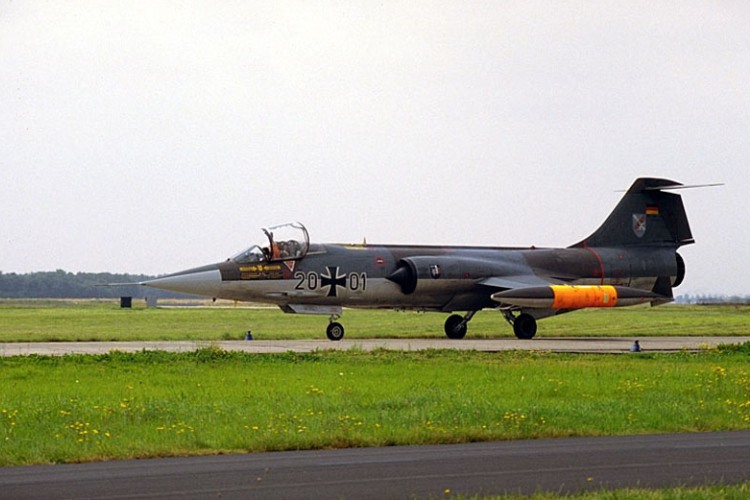 |
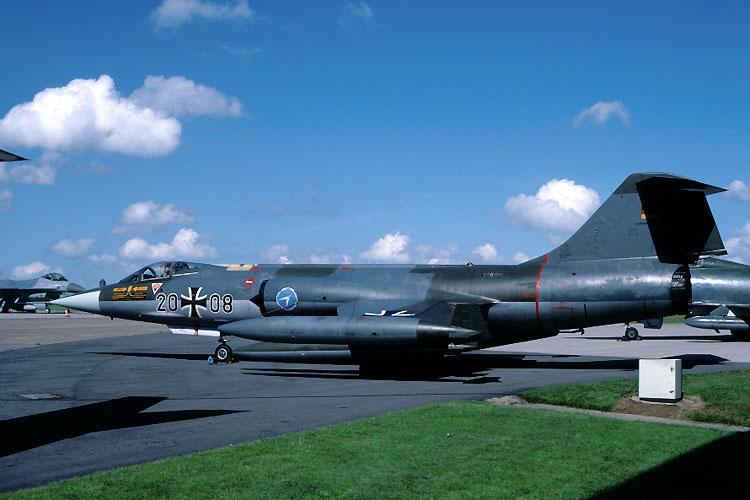 |
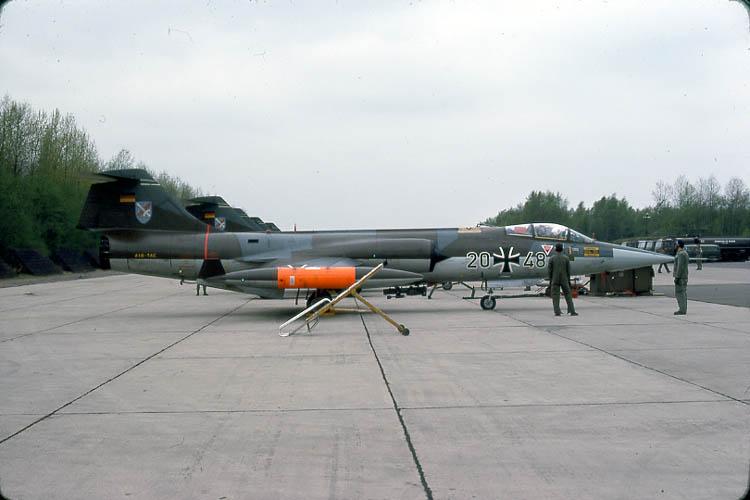 |
|
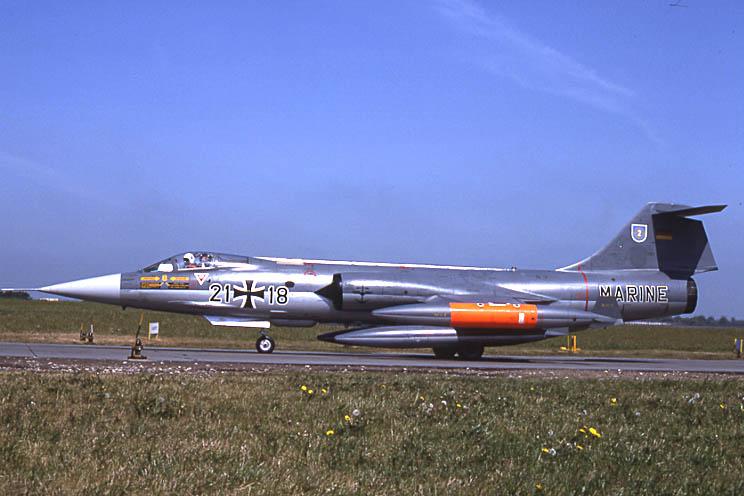 |
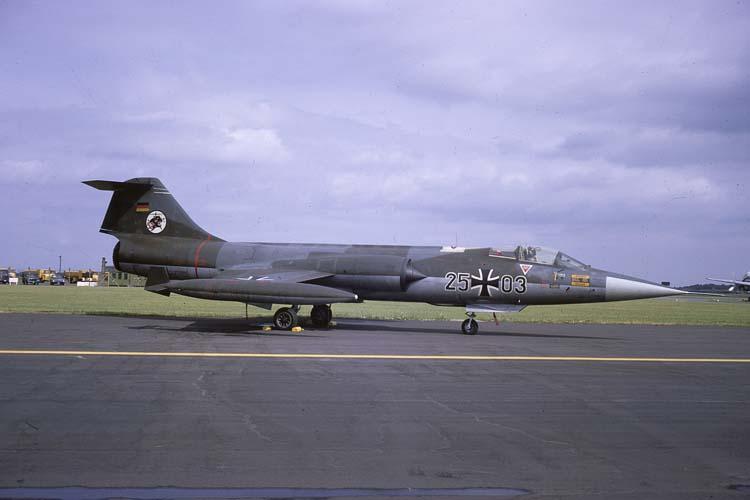 |
 |
|
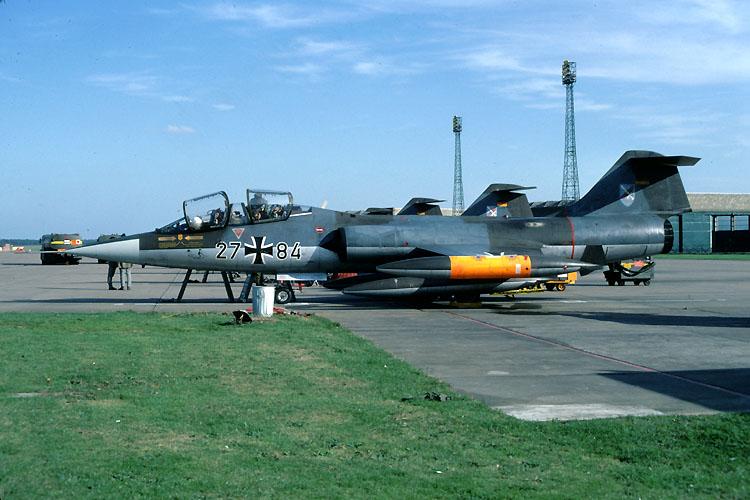 |
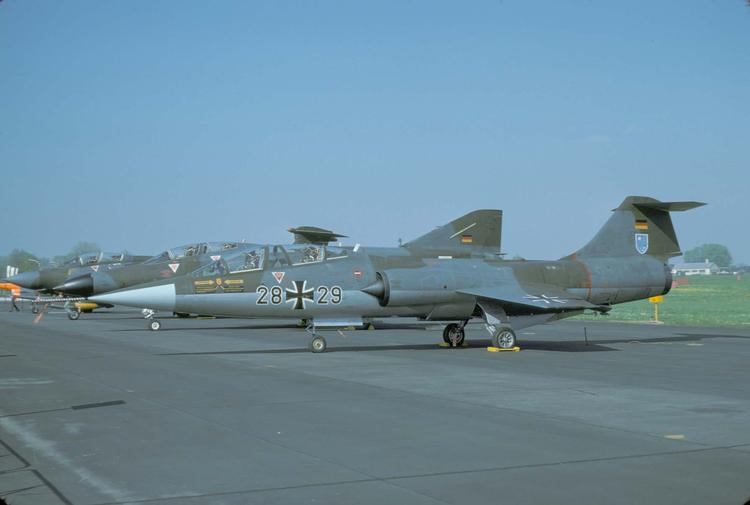 |
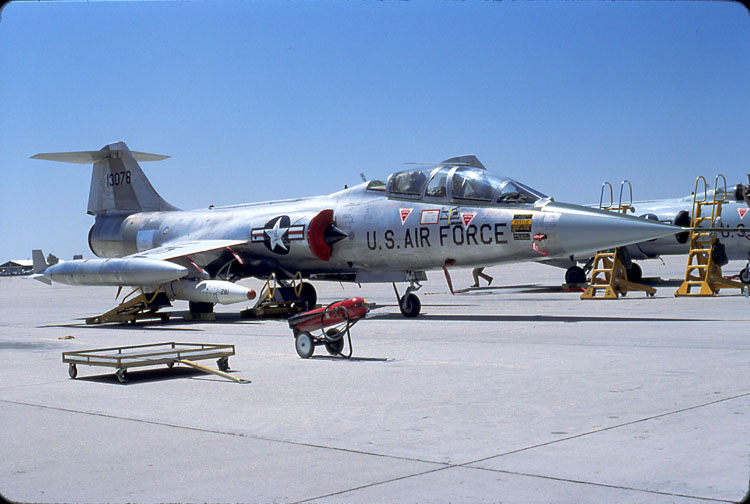 |
|
 |
|
|
|